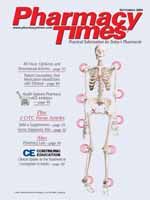Publication
Article
Pharmacy Times
Home Diagnostic Kits: Take One Test and Call the Doctor in the Morning
Author(s):
Today, more and more consumers are taking control of their health and understanding the importance of early detection and treatment. The various types of home diagnostic tests that line the shelves of pharmacies are proof that people are health-conscious. Currently, the market for home testing kits stands at about $2.8 billion, compared with only $750 million in 1992.1 The FDA has approved home testing kits for analysis of more than 26 substances or for detecting conditions such as ovulation, pregnancy, diabetes, drug abuse, high cholesterol, and HIV 1 (Table).
At one time, the only home diagnostic tests available were for monitoring blood glucose, pregnancy detection, and ovulation prediction, but now the market is flooded with various types of diagnostic aids that monitor and diagnose illnesses. Many tests that once could be performed only in a doctor's office are now available directly to the consumer. In 2003, various new at-home tests were introduced to the market that included screening for urinary tract infections, digital pregnancy tests, and ovulation tests that use saliva instead of urine.
Infertility, Ovulation, and Pregnancy Testing
In 2003, ClearBlue Easy (Unipath Diagnostics Inc) marketed a digital pregnancy test that displays the word "pregnant" or "not pregnant" on the testing device, therefore eliminating error in the interpretation of the results. Also, various manufacturers marketed microscopes that utilize saliva to detect ovulation. These tests appear to be beneficial to females with irregular cycles. Other tests available for couples facing the obstacle of infertility allow males to test sperm concentration.
Cholesterol Testing
Cholesterol testing enables individuals to assess their cardiovascular risks and may motivate some people to modify unhealthy lifestyle habits and seek proper medical care from a physician. These tests, however, provide only total cholesterol level and not a complete lipid profile that distinguishes low-density lipoprotein (LDL) from high-density lipoprotein (HDL) rates. Some companies are presently working on a test that will measure HDL, LDL, and triglycerides separately.2
HIV Testing
In 1996, the FDA approved the first and only in-home HIV testing kit, the Home Access Express HIV-1 test system, manufactured by Home Access Health Corp. The blood sample is collected by the consumer and mailed to a laboratory with an identification number. The results are obtained from a trained counselor. Both pre- and post-counseling are available for all consumers.3
Benefits Versus Limitations of At-home Tests
The major advantages of at-home testing include privacy, convenience, expedient results, and low cost. Although these tests may be beneficial in a number of ways, they can have limitations that may cause serious health consequences for individuals who rely solely on them instead of following up with their physician. The tests are designed to help identify certain conditions and not to replace routine physician examinations.
Females who use home pregnancy tests can employ the results to obtain prenatal care earlier and possibly prevent problems in the pregnancy. Diabetics can monitor blood glucose levels on a routine basis, which aids in reducing the development of potential complications. These patients also can detect conditions that may be asymptomatic, such as hypercholesterolemia, thus enabling them to seek medical treatment and possibly prevent further complications.
Selecting a Home Diagnostic Kit
Because there is such an extensive array of diagnostic products on the market today, selecting the appropriate test may be overwhelming and confusing to consumers. The FDA classifies home-use test kits in 2 categories4:
- Test Kits?the consumer collects the sample, performs the test, and reads the results
- Collection Kits?the consumer collects the sample, mails it to a laboratory, and obtains the results via telephone
Selection should be based on complexity of the test procedure, ease of interpreting results, and cost. In the majority of test kits, results can be read after an indicator changes color. Because human error plays a crucial role in test results, it is recommended that consumers use kits with more than 1 test to ensure the validity of the results. Proper collection, storage, and shipment of specimens are crucial to obtaining accurate results. It is important for consumers to consult a health care professional, if needed, as well as the consumer help information found in most kits.
The Role of the Pharmacist
Pharmacists can play an integral role in patient care by helping the consumer make proper selections of test kits and by encouraging physician follow-up, especially if a consumer is uncertain about the accuracy of the pending test results. Although patients are becoming more aware of preventive health care measures, pharmacists have the ultimate responsibility to ensure that patients make the right choice, based on education tailored to the needs of each individual. Pharmacists should stress to their patients that the use of these tests always should be followed up with a physician's visit.
Because not all home diagnostic tests are regulated or approved by the FDA, consumers should protect themselves by referring to the following Web sites for a comprehensive listing of all FDA-approved home testing devices:
www.fda.gov/cdrh/oivd/consumer-otcdatabase.html
www.fda.gov/cdrh/oivd/consumer-homeuse.html
www.pharm.uky.edu/hometest/kitshp.html
www.fda.gov/cdrh/ode/otctable.html
www.fda.gov/search/databases.html
For a list of references, send a stamped, self-addressed envelope to: References Department, Attn. A. Stahl, Pharmacy Times, 241 Forsgate Drive, Jamesburg, NJ 08831; or send an e-mail request to: [email protected].
Ms. Terrie is a clinical pharmacy writer based in Slidell, La.

Newsletter
Stay informed on drug updates, treatment guidelines, and pharmacy practice trends—subscribe to Pharmacy Times for weekly clinical insights.






